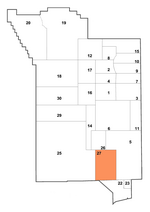
Area 27 is a division of the Nevada National Security Site. It occupies approximately 49 square miles (130 km2) in the south-central portion of the NNSS. [1] A portion of Area 27 was originally known as Area 410. [2]
No tests of nuclear weapons took place in Area 27. [3]
History
Area 27 was used for weapons assembly and staging. [1]

The Super Kukla Reactor Facility was built in Area 27 and operated from 1965 to 1978. A major U.S. concern in the Cold War was Soviet use of defensive tactical nuclear weapons. Nuclear-armed interceptors and anti-ballistic missiles could be used to intercept a U.S. attack. To simulate nearby nuclear explosions, the Super Kukla reactor produced an ultrahigh burst of prompt critical neutrons and gamma rays. This could be used to test the effects on weapons hardware. [4] Super Kukla is now entombed in place at Area 27. [5]
Joint Actinide Shock Physics Experimental Research

Area 27 is home to the Joint Actinide Shock Physics Experimental Research (JASPER) Facility. [1]
JASPER uses a two-stage high-energy shock gun to achieve shock pressures, temperatures, and strain rates similar to those attained in a nuclear weapon. [6] It is specifically designed to conduct research using plutonium and surrogate materials as targets. [6] Data from these experiments is used to determine material equations of state and to validate computer models of material response for weapons applications. JASPER experiments support the Stockpile Stewardship Program and complement subcritical experiments conducted in Area 1. [6]
The facility is located in a decommissioned weapons assembly complex and was established in 1999. [7] By April 2003, qualification testing using non-nuclear materials was complete. [8] By May 2007, a series of tests comparing new plutonium weapons pits with old ones had confirmed that the plutonium cores in US weapons stockpiles were less subject to deleterious aging effects than previously anticipated. [9]
References
- ^ a b c National Nuclear Security Administration / Nevada Site Office, Draft Site-Wide Environmental Impact Statement Nevada, ch.2, July 2011, DOE/EIS-246-D
- ^ Nevada Test Site Guide, National Nuclear Security Administration, DOE/NV-715
- ^ U.S. Department of Energy / Nevada Operations Office, United States Nuclear Tests - July 1945 through September 1992, December 2000, DOE/NV-209 Rev 15 Archived October 12, 2006, at the Wayback Machine
- ^ Parker, Ann (2002). "Knowing the Enemy, Anticipating the Threat". Science & Technology Review. Lawrence Livermore National Laboratory. Archived from the original on 6 September 2015.
- ^ Las Vegas Review-Journal. 16 February 2008. Keith Rogers. U.S. NUCLEAR WEAPONS DEVELOPMENT: Test site profile revamped: Little-known Super Kukla delineated
- ^ a b c U.S. Department of Energy / Nevada Operations Office, Joint Actinide Shock Physics Experimental Research (JASPER) Fact Sheet, January 2011, DOE/NV-1015
- ^ Plan of Action: JASPER Management Prestart Review (Surrogate Material Experiments). W. E. Cooper. 23 October 2000. Lawrence Livermore National Laboratory. U.S. Department of Energy.
- ^ LLNL. Science & Technology Review, June 2004. Shocking Plutonium to Reveal Its Secrets
- ^ "LLNL. Science & Technology Review, May 2007. U.S. Weapons Plutonium Aging Gracefully". Archived from the original on 2013-02-17. Retrieved 2011-12-02.
![]() This article incorporates
public domain material from websites or documents of the
United States Department of Energy.
This article incorporates
public domain material from websites or documents of the
United States Department of Energy.